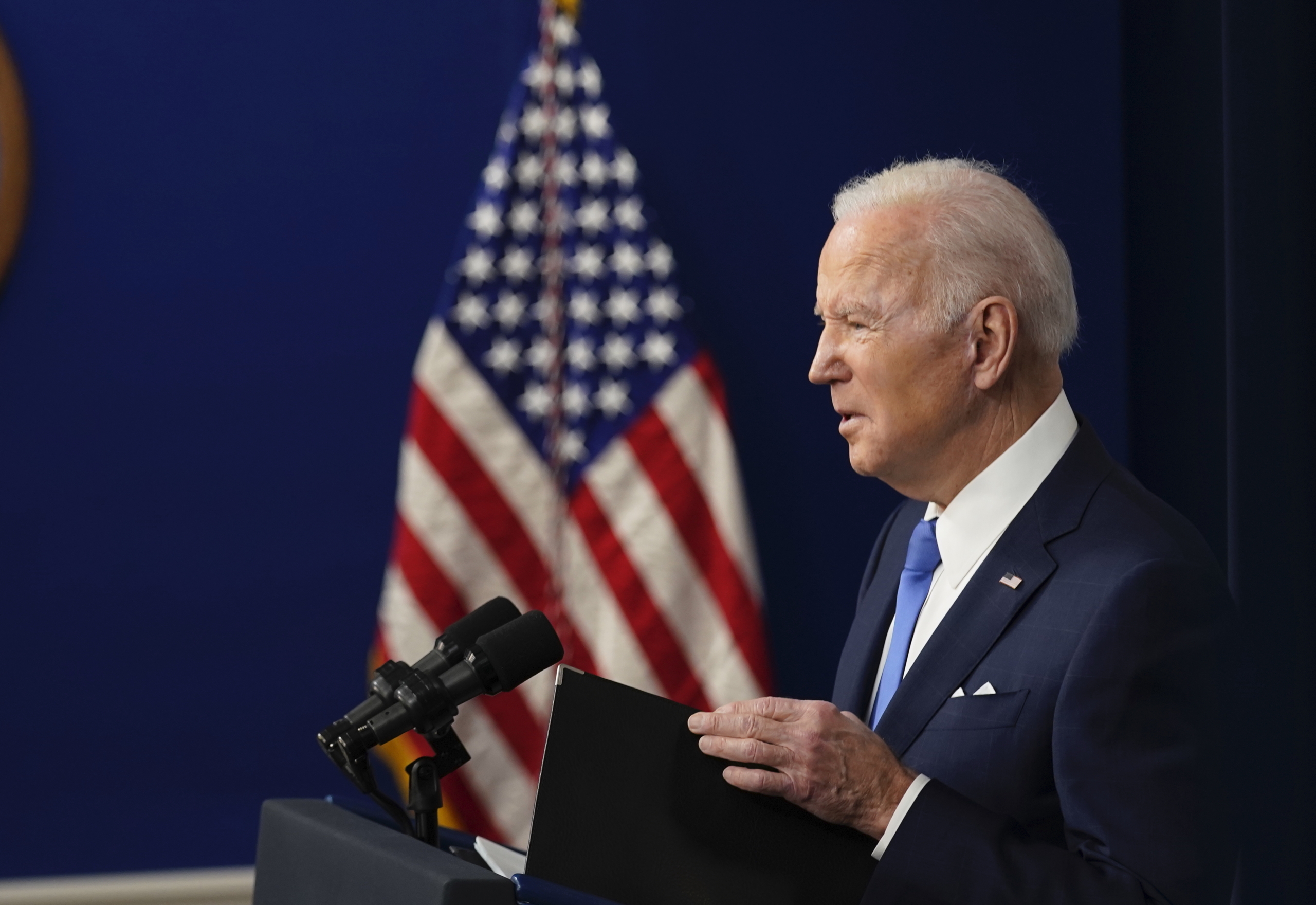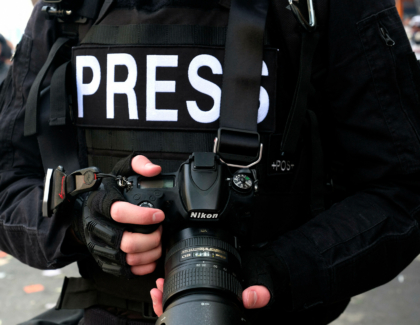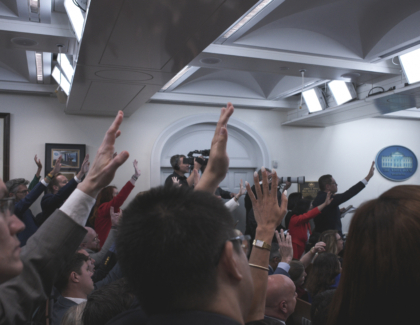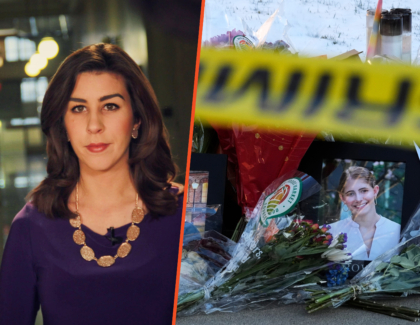Sign up for the daily CJR newsletter.
Joe Biden was inaugurated as president of the United States a year ago tomorrow, and as the anniversary has approached, the “first year” takes have intensified to a deluge. These started in earnest a month or so ago, reminding me of the time that ABC assessed Biden’s first hundred days after eighty-one days (though I guess the end of his first calendar year was somewhat less arbitrary). Since then, we’ve seen photo-essays, scorecards, and stats—How many judges did he appoint? How long did he spend at his homes in Delaware?—as well as analyses weighing his performance across key policy areas, from covid-19 to the climate crisis.
We’ve seen similar reflections on the state of Biden’s relationship with the press. Last February, after Biden had been in office for a month, I wrote that early pundit giddiness at the (mostly) respectful normality of his press operation—Van Jones on Jen Psaki’s first briefing as press secretary: “There was a human, and that person said words, and the words made sense”—had given way to frustration with Biden’s personal inaccessibility to reporters, even though Psaki had restored the daily briefing and other officials were talking regularly to national and local outlets, including some serving Spanish-speaking, Black, or niche audiences. Eleven months on, and these trends have mostly continued, not least the loud griping about Biden’s lack of availability. Last month, White House reporters at major outlets complained to Vanity Fair’s Charlotte Klein that their interview requests had largely gone unanswered: Biden had done fourteen sit-downs and town halls on TV but only three with print outlets, compared with Donald Trump’s thirty by the same point and Barack Obama’s forty-two. According to Martha Joynt Kumar of the White House Transition Project, which tracks such things, Biden has also held fewer formal press conferences than any of his immediate predecessors had by this point: just nine, compared with twenty-two for Trump and twenty-seven for Obama.
ICYMI: Covering the Republican assault on American democracy
The administration has pushed back on claims that it’s falling short of its lofty transparency promises. Psaki has said that reporters don’t need to be seated on “embroidered cushions” in a formal setting to ask questions, with Biden fielding impromptu queries in the course of his daily business more often than any president since Bill Clinton; press officials also note that Biden has both toured the country and used social media to share his policies, chatting with influencers (Olivia Rodrigo, Bill Nye the Science Guy) to meet young voters where they are (which is not watching cable news). Still, critics point out that the latter aren’t hard journalistic settings, and that informal Q&As are often too brief for rigorous scrutiny, with Biden able to dodge questions he doesn’t want to field, or to drop a hot talking point and run. Even some of Biden’s political allies have expressed concern about his lack of deeper engagement with traditional media, arguing that he’s ceding the narrative about his presidency to louder, more hostile voices. “Every network would give him time if he asked for it,” Kurt Bardella, a Democratic adviser, told the New York Times. “He needs to use the trappings of the presidency.”
Transparency, of course, is about more than just press conferences. Last week, the Committee to Protect Journalists published a report by Leonard Downie Jr., a former executive editor of the Washington Post, that sought to assess the question through the broader lens of press freedom. It concluded that there is a “night and day” difference between Biden and Trump when it comes to their rhetoric toward the press, and praised Biden on other grounds, too. His administration moved on day one to restore the credibility and independence of Voice of America, a US-funded international broadcaster, after Trump rampantly politicized it. After initially defending a Trump-era move to subpoena the phone records of several Post reporters in the course of a leak investigation, meanwhile, Biden’s Justice Department reversed course and pledged to stop surveilling reporters. (Biden himself catalyzed this promise. The setting for his doing so? An informal Q&A.)
Still, the new policy on surveillance contains some gray areas and has yet to be enshrined in formal prosecutorial guidelines, let alone federal law. And in various other areas, Biden’s press-freedom record is spottier still. Public-records experts told CPJ that responsiveness to Freedom of Information Act requests has not markedly improved on Biden’s watch. For reasons of explicit diplomatic self-interest, the administration refused to personally punish Saudi crown prince Mohammed bin Salman, despite concluding publicly that he ordered the murder of the dissident Post columnist Jamal Khashoggi. As Afghanistan fell to the Taliban and the US withdrew, officials made it easier for endangered journalists who worked with American outlets to get US visas, without offering equivalent practical support to help them flee. The administration has pushed ahead with a Trump-era move to extradite Julian Assange, the WikiLeaks founder, from the UK on espionage charges that effectively criminalize certain routine reporting practices. And it has often impeded reporting at the US border with Mexico.
Which brings us back to access. I wrote last March, amid a media feeding frenzy on Biden’s early immigration record, that while access to the border is important, it’s not everything. Broadly speaking, a similar frame might be applied to the entirety of Biden’s early relations with the press. Access, again, is important, and more of it would be better—especially access to Biden personally. But access to the president is not the be-all and end-all of access to the presidency: Psaki has continued to hold regular briefings, and various departments and agencies under Biden’s command, including State and Defense, have done likewise. What officials say remains more important than the format in which they say it. (Trump often used his relative accessibility to reporters to make them props in his “fake news” rhetoric.) And—despite the outsize attention paid to his meager interview-and-presser metrics—access has little to do with Biden’s most egregious media missteps, which, to my mind, all come under the press-freedom banner. A successful espionage prosecution of Assange would be much worse for American journalism than Biden sitting down with the Times columnist David Brooks but snubbing his news-side colleagues.
Ultimately, access to the president is only useful if reporters do something useful with it. After Biden took office, various members of the press clamored obsessively for him to hold a formal press conference, but when he finally acquiesced, in March, White House correspondents peppered him with a barrage of inane questions about his political standing without asking once about covid—a missed opportunity, theGrio’s April Ryan (who was present but not called on to ask a question) noted at the time, to bring up vaccine-equity gaps, among other important topics. Today, at 4pm Eastern, Biden will host what, by one count, will be his “first formal solo news conference at the White House” since then. It’s already being billed as an opportunity for Biden to reset at a difficult moment in his presidency. It’s a chance for the press to reset, too.
Below, more on Biden, the media, and politics:
- Friends like these: Politico’s Max Tani and Alex Thompson write that columnists who have generally been supportive of Biden’s presidency—including Brooks and Thomas Friedman, of the Times, and Jennifer Rubin, of the Post—are starting to wobble. Depending on who you ask, their critiques “are either evidence that Biden does need to break with the left-wing activists who are overrepresented on Twitter; or the classic whinings of clueless Beltway pundits,” Tani and Thompson write. “Either way, Biden is losing the confidence of commentators he and his team have long valued. Brooks’ opinion doesn’t matter to many elected Democrats, but it matters to Biden himself.”
- The vice president and the press: Late last year, amid a barrage of negative headlines, Vice President Kamala Harris also had to contend with turnover in her communications operation, with Ashley Etienne, her comms director, and Symone Sanders, her top spokesperson, leaving the White House. (Both were reportedly expected to leave; Sanders has since landed at MSNBC.) Two weeks ago, Harris tapped Jamal Simmons, a longtime Democratic comms aide, to replace Etienne, but the pick has since run into controversy after old tweets surfaced in which Simmons said he’d seen undocumented immigrants talking on MSNBC and wondered why ice hadn’t come to arrest them. Simmons apologized; he will meet with Hispanic lawmakers tomorrow.
- “The Trouble with Frictionless Briefings”: For CJR’s recent magazine on political journalism after Trump, Hunter Walker, a former White House correspondent for Yahoo News who now has a Substack, reflected on the pluses and minuses of the Biden administration’s approach to the press. The “existential” Trump-era threat to the daily briefing has passed, as has Trump’s barrage of lies, Walker wrote. “Yet the White House press corps has lost something from the Trump years: nearly unfettered access to behind-the-scenes drama and the presidential id, through freewheeling speeches and stream-of-consciousness updates on Twitter. Biden’s highly professional press shop makes it harder for the media to penetrate the depths of the White House—internal debates, developing ideas—and to locate pressure points that can take things off script.”
- Meanwhile, in out of Trumpworld: Yesterday, CNN’s Jake Tapper reported that dozens of former Trump administration officials—including his former chief of staff John Kelly and comms directors Alyssa Farah Griffin and Anthony Scaramucci—recently held a conference call to discuss how they might fight their old boss’s attacks on democracy, though they didn’t seem to agree on a path forward. Writing for Rolling Stone, Jack Crosbie warns the press not to fall for the exercise. Disillusioned former Trump staffers have “clearly made the call that associating with the country’s political center is a better long-term choice than doubling down on Trump-aligned extremism,” Crosbie argues. “And who knows, it could work—especially with a friendly media ecosystem designed to reward them for doing things like ‘scheduling a conference call.’ ”
Other notable stories:
- On Tuesday, the world got a first official update out of Tonga, which was hit by a tsunami over the weekend after a volcano erupted under the Pacific Ocean; the government described an “unprecedented disaster” and said that three people had died. News of the tsunami’s impact has been slow to come out since the eruption severed a submarine internet cable; for the MIT Technology Review, Chris Stokel-Walker assessed what it will take to get the cable fixed. Meanwhile, aid workers are figuring out how to help Tonga without importing covid. Only one case has ever been reported in the country.
- Last week, the New York Post fired Michelle Gotthelf, the top editor of its website. Yesterday, Gotthelf claimed in a lawsuit that she was dismissed without cause after complaining about “several years of sex-based harassment” at the paper; among other things, she alleges that Col Allan, the former top editor, propositioned her for sex and was abusive toward her, including after she contested his order to remove a story about a rape claim against Trump from the Post’s website. (The Post contested her account.)
- The union representing staffers at New York magazine reached a deal with management, after years of contract talks. The agreement includes a salary floor, guaranteed annual raises, layoff protections, and a ban on management using nondisclosure agreements around harassment or discrimination; it also regulates staffers’ TV and film rights. Allison Prang has more for the Wall Street Journal.
- Seven staffers at the AV Club, a pop-culture site owned by G/O Media, lost their jobs after refusing a management order that they relocate from Chicago to LA, cutting the site’s editorial team nearly in half. G/O bosses said that they outlined the move nearly two years ago, but the union representing AV staffers disputed this, saying that staffers were only given an ultimatum last month. Katie Robertson has more for the Times.
- In the fall, Chicago Public Media said that it was exploring a deal to bring the Chicago Sun-Times newspaper, which has struggled financially of late, under the same nonprofit banner as WBEZ, the city’s NPR station. Yesterday, Chicago Public Media’s board voted to approve the merger, which is expected to close by the end of the month and will create one of the biggest local-news nonprofits in the US. Robert Feder has more.
- In media-jobs news, Paul Tash is retiring as CEO of the Tampa Bay Times after nearly fifty years at the paper. Elsewhere, Kendis Gibson, an anchor at MSNBC, is joining the CBS station in Miami in a bid to get away from “hyper-partisan, 24/7” political news. Eriq Gardner, of the Hollywood Reporter, is joining Puck. And Capital B, a nonprofit for Black audiences, announced several hires, including Margo Snipe as national health reporter.
- Sara Fischer reports, for Axios, that Al Jazeera has “quietly sidelined” Rightly, a controversial digital outlet that it launched last year in a bid to appeal to conservative viewers. Al Jazeera “ended its show for Rightly in December,” Fischer writes. “Those who worked on it weren’t given much of an explanation or heads up, but a source who worked on the show said ‘a budgetary decision was the way it was explained to me.’ ”
- Nieman Lab’s Hanaa’ Tameez spoke with Dr. Rebecca Whittington, the first ever online-safety editor at Reach, a chain of papers in the UK. “We are hearing that there is more abuse and hate taking place against women and people of color,” Whittington said, referring to Reach’s staff. “We are also seeing journalists, on a daily basis, being told they’re worth rubbish, why don’t they go and get another job somewhere else.”
- And Mexico lost two more journalists within a week of each other. Last Monday, José Luis Gamboa, who ran a news site and had recently criticized official complicity with drug cartels, was fatally stabbed in Veracruz state. Then, on Monday of this week, Margarito Martínez Esquivel, a photojournalist who covered crime and security, was shot dead outside his home. He had worked for US outlets including the San Diego Union-Tribune.
ICYMI: In France, an extraordinary musical interview sparks a debate on ‘infotainment’
Has America ever needed a media defender more than now? Help us by joining CJR today.







